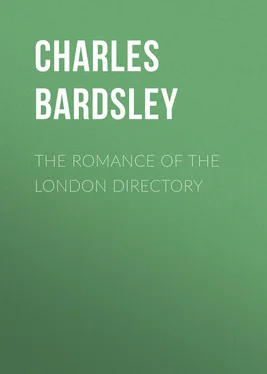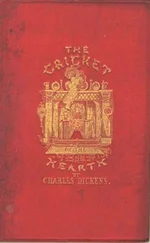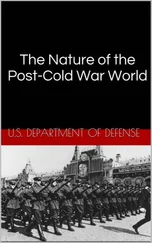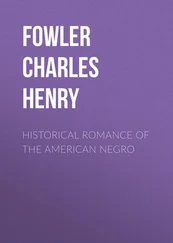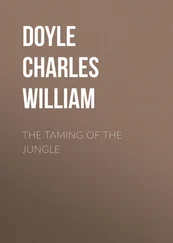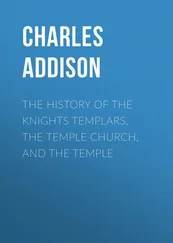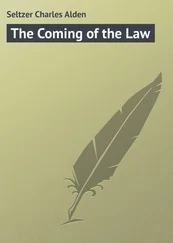Charles Bardsley - The Romance of the London Directory
Здесь есть возможность читать онлайн «Charles Bardsley - The Romance of the London Directory» — ознакомительный отрывок электронной книги совершенно бесплатно, а после прочтения отрывка купить полную версию. В некоторых случаях можно слушать аудио, скачать через торрент в формате fb2 и присутствует краткое содержание. Жанр: foreign_antique, foreign_prose, на английском языке. Описание произведения, (предисловие) а так же отзывы посетителей доступны на портале библиотеки ЛибКат.
- Название:The Romance of the London Directory
- Автор:
- Жанр:
- Год:неизвестен
- ISBN:нет данных
- Рейтинг книги:5 / 5. Голосов: 1
-
Избранное:Добавить в избранное
- Отзывы:
-
Ваша оценка:
- 100
- 1
- 2
- 3
- 4
- 5
The Romance of the London Directory: краткое содержание, описание и аннотация
Предлагаем к чтению аннотацию, описание, краткое содержание или предисловие (зависит от того, что написал сам автор книги «The Romance of the London Directory»). Если вы не нашли необходимую информацию о книге — напишите в комментариях, мы постараемся отыскать её.
The Romance of the London Directory — читать онлайн ознакомительный отрывок
Ниже представлен текст книги, разбитый по страницам. Система сохранения места последней прочитанной страницы, позволяет с удобством читать онлайн бесплатно книгу «The Romance of the London Directory», без необходимости каждый раз заново искать на чём Вы остановились. Поставьте закладку, и сможете в любой момент перейти на страницу, на которой закончили чтение.
Интервал:
Закладка:
There are endless allusions to the signs of old London in the comic or semi-comic rhymes of the period. Thomas Heywood, early in the seventeenth century, says: —
“The gintry to the King’s Head ,
The nobles to the Crown ,
The knights unto the Golden Fleece ,
And to the Plough the clowne.
The Churchman to the Mitre ,
The shepherd to the Star ,
The gardener hies him to the Rose ,
To the Drum the man of war.”
There is a capital collection of these names in a ballad of the Restoration, which is far too long to quote in full, but of which the following is a specimen: —
“Through the Royal Exchange as I walked,
Where gallants in sattin doe shine,
At midst of the day they parted away,
To seaverall places to dine.
The ladyes will dine at the Feathers ,
The Globe no captaine will scorne,
The huntsman will goe to the Greyhound below,
And some will hie to the Horne .
The farriers will to the Horse ,
The blacksmith unto the Locke ,
The butchers unto the Bull will goe,
And the carmen to Bridewell Clocke .
The pewterers to the Quarte Pot ,
The coopers will dine at the Hoope ,
The coblers to the Last will goe,
And the bargemen to the Sloope .
The goldsmith will to the Three Cups ,
For money they hold it as drosse;
Your Puritan to the Pewter-canne ,
And your Papists to the Crosse .
Thus every man in his humour,
That comes from the northe or the southe;
But he that has no money in his purse
May dine at the signe of the Mouth .”
Again, Pasquin, in his “Night-cap,” says: —
“First there is Maister Peter at the Bell ,
A linen draper, and a wealthy man;
Then Maister Thomas that doth stockings sell,
And George the grocer at the Frying Pan .
And Maister Miles the mercer at the Harrow ,
And Maister Mike the silkman at the Plow ,
And Maister Nicke the Salter at the Sparrow ,
And Maister Dicke the vintner at the Cow .”
Another jingling rhyme began: —
“I’m amused at the signs
As I pass through the town,
To see the odd mixture, —
A ‘Magpie and Crown,’
The ‘Whale and the Crow,’
The ‘Razor and Hen,’
The ‘Leg and Seven Stars,’
The ‘Scissors and Pen,’
The ‘Axe and the Bottle,’
The ‘Tun and the Lute,’
The ‘Eagle and Child,’
The ‘Shovel and Boot.’”
These double signs were very common, and are easily explained. Now-a-days a man who has taken the goodwill of a well-established shop paints over the door “Snooks, late Jopson, Chemist.” The apprentice in old days added his own badge to that of his late master, and the signboard displayed perhaps the “Mermaid and Gridiron,” or the “Leg and Crow,” the old sign being linked to the new.
The reader may think I have dwelt somewhat long upon this matter; but I am writing about localization, and these signboards in their day were the only means of identifying the London tradesman. Names and numbers were practically useless. How small a proportion of the London population could read even two hundred years ago! Mr. Baxter might have “Baxter” in the largest gilt characters over his front; he might further add that he made and sold that newly-discovered luxury tobacco on the counter within, – but how many of the passers-by would be any the wiser! But if he had a large swinging board at the end of a pole, facing the wayfarers, with a huge Turk’s head with a pipe in its mouth, there was none but could tell his occupation. Sometimes the real article was exhibited. The hosier would dangle a pair of stockings from his pole. Thus it was that every shopkeeper was known by his sign. The housewife would send little Tom to the “Cock,” or the “Three Cranes,” or the “Ark,” or the “Hand-in-hand” for her little domestic wants, where now she would bid him run to “Tomkins’,” or “Sawyer’s,” or “Robinson’s.” In course of time the sign did not always harmonize with the articles sold within, but it was quite enough for the neighbours dwelling around. What an array of creaking posts and grotesque frames must there not have been along the leading thoroughfares, such as Cheapside, and old London Bridge! and leaving out the question of discomfort, and the perils of a broken head if you drove on a coach, what a picturesque scene it must have been!
I dare not say what a large proportion of names in the London Directory that look like nicknames must be set down as the result of this old-fashioned custom. The fourteenth century saw London streets looking as if hung with bannerets, so crowded were they with signs. That was a period when half of the lower middle class were still without an hereditary surname. The consequence is, we find such entries as “Hugh atte Cokke,” or “Thomas atte Ram,” or “Thomas del Hat,” or “Margery de Styrop.” The reader must see at a glance that we have here the origination of half our “Cocks” and “Coxes,” “Rams,” “Roebucks,” “Tubbs,” “Bells,” “Crows.” There are three “Hatts” to forty-one “Heads,” three “Pates” and two “Crowns” in the London Directory, not to mention three “Harrows,” two “Plows,” four “Boots,” and ten “Pattens.” All these, and a hundred other names that appear difficult of origination, are easily explained when we recall this faded custom of a few centuries ago.
The plan of having numbered doors came into use but very recently. The signboards were disused in many parts of London before numerals were instituted. The addresses on letters appeared very strange as a consequence.
John Byrom, the great epigrammatist, writing to his wife from Cambridge in 1727, addresses his letter to “Mistress Eliz. Byrom, near the old Church, in Manchester.” That was the ordinary method, to choose some big well-known building, and state your friends’ position to it by the compass. The first Directory ever published, of any pretensions, was Kent’s, in 1736. “The Directory,” it is called, “sold by Henry Kent, in Finch Lane, near the Royal Exchange.” It contains about 1200 names, all the tradesmen and merchants of London. There are such entries as “Samuel Wilson, hardwareman, in Cannon Street, the corner of Crooked Lane,” or “John Bradshaw, opposite the Monument, at a barber’s.”
Manifestly this could not go on. In the edition for 1770 occurs the following: “The Directory.. with the numbers as they are affixed to their houses, agreeable to the late Acts of Parliament.” The Legislature had had to take the matter into hand. London was getting far too big for indistinct addresses such as these. The first street in the metropolis to possess numbered doors was New Burlington Street. This was accomplished in June 1764. Other important throughfares followed suit, and before ten years had gone by, we find the Directory particularizing as follows: “John Trelawney, haberdasher, No. 22, Nightingale Lane,” or “Hamnett Townley, hop merchant, No. 69, Great Tower Street.” Occasionally a “Vincent Trehearn, hatmaker, behind St. Thomas’s,” comes, but rarely; and by-and-by such entries disappear altogether. Manchester began the same practice in 1772, at the request of the borough reeve and constable, and was the second town in the kingdom to adopt the practice.
It was reserved for the year 1877 to put a climax, I think, to ingenuity of this kind. In Manchester, probably in London also, there are lamp-post Directories. You cannot always have a Directory at your elbow. Even this difficulty is remedied by the lamp-post Directory. The names of all shopkeepers in that particular street wherein the lamp-post stands are printed alphabetically on a circular tablet, which revolves round the post. You turn it round till you find the name you want.
Читать дальшеИнтервал:
Закладка:
Похожие книги на «The Romance of the London Directory»
Представляем Вашему вниманию похожие книги на «The Romance of the London Directory» списком для выбора. Мы отобрали схожую по названию и смыслу литературу в надежде предоставить читателям больше вариантов отыскать новые, интересные, ещё непрочитанные произведения.
Обсуждение, отзывы о книге «The Romance of the London Directory» и просто собственные мнения читателей. Оставьте ваши комментарии, напишите, что Вы думаете о произведении, его смысле или главных героях. Укажите что конкретно понравилось, а что нет, и почему Вы так считаете.
